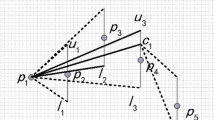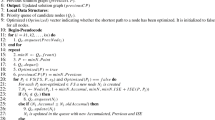Abstract
In many real application, the volume of time series data increases seriously. How to store and process data becomes more interesting and challenge things. Effective representations can make storage less, processing more easily. In this paper, we contribute to construct a new piecewise linear approximation algorithm for segmenting online time series with error bound guarantee. To beat our targets, we combine a disconnected segment strategy into Feasible Space Window method, and to test our algorithm, we compare with algorithms that adopts the above strategies on both real and synthetic data sets. The time complexity of our algorithm is O(n) and the number of segments is smaller than FSW algorithm on all tested data sets.














Similar content being viewed by others
Abbreviations
- δ:
-
A given error bound on each data point
- P :
-
A time series
- F :
-
A set of linear line
- p k :
-
The k-th data point in time series
- \( \widetilde{{p_{k} }} \) :
-
The k-th intersection by represent line
- \( \underline{{p_{i} }} \) :
-
Data point with deleted tolerant error
- \( \overline{{p_{i} }} \) :
-
Data point with added tolerant error
- p start :
-
The starting point
- p next :
-
The next coming data point
- \( p_{{t_{e} }} \) :
-
The data point at which the FSW becomes empty
- \( p_{{t_{e} }}^{'} \) :
-
The joint point at t e
- u :
-
An upper boundary line
- l :
-
A lower boundary line
- n s :
-
The number of segments
- \( \underline{{p_{{t_{e} }} }} \) :
-
The intersection point at t e by l
- \( \overline{{p_{{t_{e} }} }} \) :
-
The intersection point at t e by u
References
Koski A, Juhola M, Meriste M (1995) Syntactic recognition of ECG signals by attributed finite automata. Pattern Recogn 28(12):1927–1940
Lee LC-H, Liu A, Chen W-S (2006) Pattern discovery of fuzzy time series for financial prediction. IEEE Transa Knowl Data Eng 18(5):613–625
Sripada SG, Reiter E, Hunter J, Yu J (2003) Segmenting time series for weather forecasting. Applications and innovations in intelligent systems X, pp 193–206
Wang X-Z, He Y-L, Wang D-D (2013) Non-Naive Bayesian classifiers for classification problems with continuous attributes. IEEE Trans Cybern. doi:10.1109/TCYB.2013.2245891
Appel U, Brandt AV (1983) Adaptive sequential segmentation of piecewise stationary time series. Inf Sci 29(1):27–56
Keogh E et al (2004) Segmenting time series: a survey and novel approach. In: Data mining in time series databases, vol 57, pp 1–22
Liu X, Lin Z, Wang H (2008) Novel online methods for time series segmentation. IEEE Trans Knowl Data Eng 20(12):1616–1626
Xie Q, Pang C, Zhou X, Zhang X, Deng K (2014) Maximum error-bounded piecewise Linear Representation for online stream approximation. VLDB J (accepted)
Qi J, Zhang R, Ramamohanarao K, Wang H, Wen Z, Wu D (2013) Indexable online time series segmentation with error bound guarantee. World Wide Web 1–43
Keogh E, Zhu Q, Hu B, Hao Y, Xi X, Wei L, Ratanama-hatana CA (2014) The ucr time series classification/clustering home-page. http://www.cs.ucr.edu/˜eamonn/time_series_data/
Letchford Adrian, Gao Junbin, Zheng Lihong (2013) Filtering financial time series by least squares. Int J Mach Learn Cybern 4(2):149–154
Boucheham Bachir (2013) Efficient matching of very complex time series. Int J Mach Learn Cybern 4(5):537–550
Keogh EJ, Chu S, Hart D, Pazzani MJ (2001) An online algorithm for segmenting time series. In: ICDM, pp 289–296
Fu AC, Chung FL, Ng V, Luk, R (2001) Evolutionary segmentation of financial time series into subsequences. In: Evolutionary computation, pp 426–430
Bellman R (1961) On the approximation of curves by line segments using dynamic programming. In: Communication of ACM, p 284
Alpanas T, Vlachos M, Keogh EJ, Gunopulos D (2008) Streaming time series summarization using user-defined amnesic functions. IEEE Trans Knowl Data Eng 20(7):992–1006
Wang X-Z, Dong L-C, Yan J-H (2012) Maximum ambiguity based sample selection in fuzzy decision tree induction. IEEE Trans Knowl Data Eng 24(8):1491–1505
Acknowledgments
This work was supported by the Science and Technology Key Project of Hebei Academy of Sciences under Grant No. 2014055306 and the cooperation project between Chinese Academy of Sciences and Hebei Academy of Sciences.
Author information
Authors and Affiliations
Corresponding author
Rights and permissions
About this article
Cite this article
Zhao, Hy., Li, Gx., Zhang, Hl. et al. An improved algorithm for segmenting online time series with error bound guarantee. Int. J. Mach. Learn. & Cyber. 7, 365–374 (2016). https://doi.org/10.1007/s13042-014-0310-9
Received:
Accepted:
Published:
Issue Date:
DOI: https://doi.org/10.1007/s13042-014-0310-9




